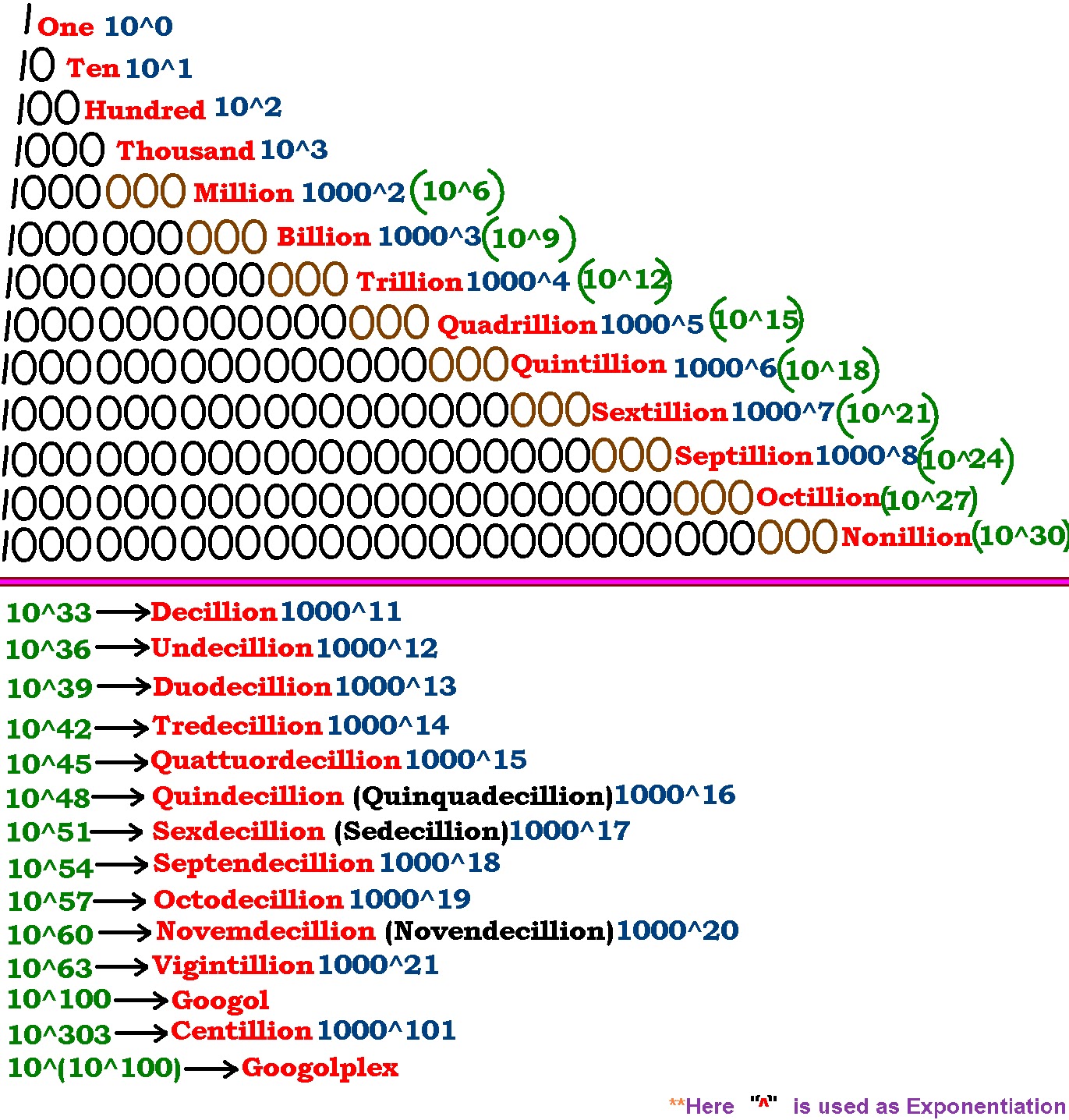What Comes After Trillion? Exploring The Breathtaking World Of Big Numbers
Alright, let's dive into something mind-blowing here. Have you ever wondered what comes after trillion? It’s not just some random number; it’s a gateway to understanding the vastness of our universe and the limits of human imagination. Numbers are like the building blocks of reality, and once you start exploring beyond trillion, you’ll realize how tiny we are in the grand scheme of things. So, buckle up, because we’re about to take a journey through the cosmos of big numbers!
You might think that once you hit a trillion, you’ve reached the pinnacle of counting. But hold your horses, my friend. The number system doesn’t stop there. In fact, it keeps going, and going, and going… kind of like the Energizer bunny, but with digits instead of batteries. This article is here to break it down for you in a way that’s easy to digest, so you won’t feel like you’re drowning in a sea of zeros.
What makes this topic even more fascinating is how it ties into science, technology, and even pop culture. From the size of the universe to the national debt of countries, big numbers play a crucial role in our daily lives. So, whether you’re a math geek or just someone who’s curious about the world, this is the article for you. Let’s get started, shall we?
- Kirsten Too Sweet Leaks The Untold Story Behind The Viral Sensation
- Masa49com The Ultimate Hub For Trending Topics And Valuable Insights
Understanding the Basics: What is a Trillion Anyway?
Before we jump into the numbers that come after trillion, let’s take a step back and talk about what a trillion actually is. A trillion is a 1 followed by 12 zeros, or 1,000,000,000,000. That’s a lot of zeros, right? But here’s the thing – it’s still just a starting point when it comes to really big numbers. Think of it like the first step on a staircase that goes on forever.
Now, why do we care about trillion? Well, it’s not just some random number. Trillion shows up in all kinds of places, from the economy to space exploration. For example, the U.S. national debt is often measured in trillions. And when astronomers talk about the distance between stars, they use trillions of miles or kilometers. So, yeah, it’s kind of a big deal.
How Big is a Trillion Really?
To give you a sense of just how massive a trillion is, let’s break it down with some fun comparisons. If you stacked a trillion one-dollar bills on top of each other, the stack would reach about 67,000 miles high. That’s more than a quarter of the way to the moon! Or, if you spent a million dollars every day since the time of Christ, you’d still need over 2,700 years to spend a trillion dollars. Mind blown yet?
- Snapgodleaks The Untold Story Behind The Scenes
- Thousandhunny Nudes The Truth Behind The Viral Sensation
What Comes After Trillion? Meet the Big Boys
Alright, so now that we’ve got a handle on trillion, let’s move on to the real stars of the show. After trillion, the numbers start getting really interesting. First up, we’ve got quadrillion. A quadrillion is a 1 followed by 15 zeros. That’s already way bigger than anything most of us can wrap our heads around. But wait, there’s more!
Next in line is quintillion, which is a 1 followed by 18 zeros. Then we’ve got sextillion, septillion, octillion, and so on. Each of these numbers adds another three zeros to the mix. So, as you can imagine, they get pretty massive pretty quickly. But here’s the thing – these numbers aren’t just made up. They have real-world applications in fields like physics, astronomy, and computer science.
Breaking Down the Numbers: A Quick Guide
- Quadrillion: 1 followed by 15 zeros
- Quintillion: 1 followed by 18 zeros
- Sextillion: 1 followed by 21 zeros
- Septillion: 1 followed by 24 zeros
- Octillion: 1 followed by 27 zeros
- Nonillion: 1 followed by 30 zeros
- Decillion: 1 followed by 33 zeros
See how it works? Every step up the ladder adds three more zeros. It’s like climbing a mountain, but instead of altitude, you’re gaining zeros. And trust me, the view from the top is pretty spectacular.
Why Do These Numbers Matter?
You might be wondering why we even need numbers this big. After all, in our everyday lives, we rarely deal with anything bigger than a few thousand. But in certain fields, these numbers are essential. For example, astronomers use them to measure distances in space. When you’re talking about light-years, you’re talking about numbers that are so big they’re almost impossible to comprehend.
Engineers and scientists also rely on these numbers when designing things like supercomputers or quantum processors. These machines operate at speeds that are measured in quintillions or sextillions of operations per second. Without a solid understanding of big numbers, we wouldn’t be able to push the boundaries of technology like we do today.
Real-World Examples of Big Numbers
Let’s take a look at some real-world examples of how big numbers are used:
- The estimated number of stars in the observable universe is around 2 sextillion.
- The number of grains of sand on all the beaches in the world is estimated to be around 7.5 sextillion.
- The total number of atoms in the observable universe is estimated to be around 10 octillion.
See how these numbers pop up in unexpected places? They’re not just abstract concepts; they have real-world significance.
Numbers Beyond Decillion: The Celestial Realm
Once you’ve made it past decillion, things start getting even crazier. After decillion comes undecillion, duodecillion, tredecillion, and so on. These numbers are so big that they start to lose their meaning in everyday language. But they’re still incredibly important in fields like cosmology and theoretical physics.
For example, some scientists estimate that the total number of particles in the universe could be as high as 10^80, which is a 1 followed by 80 zeros. That’s a number so big that it’s almost impossible to write out in full. But it’s a crucial piece of the puzzle when it comes to understanding the universe.
Fun Fact: The Largest Named Number
Did you know that the largest named number is called a googolplex? A googolplex is a 1 followed by a googol of zeros. That’s so many zeros that if you tried to write them all out, you’d run out of space in the universe. Seriously. It’s that big. And yet, it’s still just a number. Go figure.
Understanding the Scale of Big Numbers
One of the biggest challenges when dealing with big numbers is understanding their scale. It’s one thing to see a number written down, but it’s another thing entirely to truly grasp how big it is. To help with that, let’s use some fun analogies.
Imagine you’re standing at the edge of the ocean, and you decide to count every single grain of sand on the beach. If you counted one grain per second, it would take you over 200 million years to count them all. Now, imagine doing that for every beach in the world. That’s how big a sextillion is.
Visualizing Big Numbers
Another way to visualize big numbers is to think about time. If you started counting at the beginning of the universe, which was about 13.8 billion years ago, and counted one number per second, you still wouldn’t have made it to a quintillion by now. That’s how mind-bogglingly big these numbers are.
Applications of Big Numbers in Technology
Big numbers aren’t just for scientists and astronomers. They also play a crucial role in technology. For example, when you’re using a smartphone or a computer, you’re dealing with numbers that are measured in billions or trillions of operations per second. That’s how these devices are able to perform complex tasks so quickly.
Another area where big numbers come into play is cryptography. When you’re using secure websites or sending encrypted messages, the security of those systems relies on numbers that are so big they’re almost impossible to crack. Without big numbers, we wouldn’t have the level of security we enjoy today.
Big Data and the Future of Technology
As technology continues to evolve, the importance of big numbers will only increase. With the rise of big data, we’re generating more information than ever before. And all of that data needs to be processed and analyzed, which requires dealing with numbers that are measured in quadrillions or even quintillions.
Conclusion: Embrace the World of Big Numbers
So, there you have it – a whirlwind tour through the world of big numbers. From trillion to googolplex, these numbers are a testament to the power of human curiosity and imagination. They help us understand the universe, push the boundaries of technology, and solve some of the biggest challenges facing our world today.
Now, here’s where you come in. If you’ve enjoyed this article, I’d love to hear from you. Leave a comment below and let me know what you think. Or, if you’re feeling adventurous, try counting to a trillion and let me know how it goes. And don’t forget to check out some of our other articles – who knows, you might just learn something new!
Table of Contents
- Understanding the Basics: What is a Trillion Anyway?
- What Comes After Trillion? Meet the Big Boys
- Why Do These Numbers Matter?
- Numbers Beyond Decillion: The Celestial Realm
- Understanding the Scale of Big Numbers
- Applications of Big Numbers in Technology
References
All data and statistics in this article are based on information from reputable sources, including NASA, the U.S. Census Bureau, and scientific journals. For more information, check out the links below:
- Exploring Tim Lincecums Children A Journey Into The Life Of A Baseball Legends Family
- Masa 49 A Deep Dive Into The Enigmatic Period Everyones Talking About

What Comes After Trillion Data science

17 Superb Charts and Tables For Inquisitive Minds

friends4ever Technical Videos and queries!